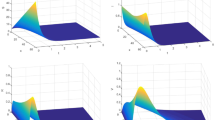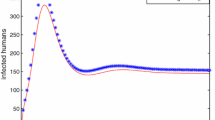Abstract
In this paper, a stochastic avian–human influenza epidemic model with logistic growth for avian population is investigated. This model describes the transmission of avian influenza among avian population and human population in random environments. The dynamical behavior of this model is discussed. Firstly, the existence and uniqueness of the global positive solution are obtained. Then persistence in the mean and extinction of the infected avian population is studied. Furthermore, sufficient conditions for the existence of an ergodic stationary distribution of stochastic avian–human influenza model are obtained. We find a threshold of this stochastic model which determines the outcome of the disease in case the white noises are small. Results show that environmental white noise is helpful for disease control. Finally, numerical simulations validate the analytical results.




Similar content being viewed by others
References
Centers for Disease Control and Prevention (CDC), Avian Influenza. https://www.cdc.gov/flu/avianflu/influenza-a-virus-subtypes.htm
Centers for Disease Control and Prevention (CDC), Avian Influenza. https://www.cdc.gov/flu/avianflu/h5n1-virus.htm
Pantin-Jackwood, M.J., Miller, P.J., Spackman, E., Swayne, D.E., Susta, L., Costa-Hurtado, M., Suarez, D.L.: Role of poultry in the spread of novel h7n9 influenza virus in China. J. Virol. 88, 5381–5390 (2014)
Li, Q., Zhou, L., Zhou, M., Chen, Z., Li, F., et al.: Epidemiology of human infections with avian influenza a (H7N9) virus in China. New Eng. J. Med. 370, 520–532 (2014)
Keeling, M.J., Rohani, P.: Modeling Infectious Diseases in Humans and Animals. Princeton University Press, Princeton (2008)
Liu, S., Ruan, S., Zhang, X.: Nonlinear dynamics of avian influenza epidemic models. Math. Biosci. 283, 118–135 (2017)
Iwami, S., Takeuchi, Y., Liu, X.: Avian–human influenza epidemic model. Math. Biosci. 207, 1–25 (2007)
Lucchetti, J., Roy, M., Martcheva, M.: An avian influenza model and its fit to human avian influenza cases. In: Tchuenche, J.M., Mukandavire, Z. (eds.) Advances in Disease Epidemiology, pp. 1–30. Nova Science Publishers, New York (2009)
Gumel, A.B.: Global dynamics of a two-strain avian influenza model. Int. J. Comput. Math. 86, 85–108 (2009)
Ma, X., Wang, W.: A discrete model of avian influenza with seasonal reproduction and transmission. J. Biol. Dyn. 4, 296–314 (2010)
Cai, Y., Kang, Y., Banerjee, M., Wang, W.: A stochastic epidemic model incorporating media coverage. Commun. Math. Sci. 14, 893–910 (2015)
Lahrouz, A., Omari, L.: Extinction and stationary distribution of a stochastic SIRS epidemic model with non-linear incidence. Stat. Probab. Lett. 83, 960–968 (2013)
Zhang, X., Jiang, D., Alsaedi, A., Hayat, T.: Stationary distribution of stochastic SIS epidemic model with vaccination under regime switching. Appl. Math. Lett. 59, 87–93 (2016)
Zhang, X., Jiang, D., Hayat, T., Alsaedi, A.: Periodic solution and stationary distribution of stochastic S-DI-A epidemic models. Appl. Anal. (2016). doi:10.1080/00036811.2016.1257123
Zhang, X., Wang, K.: Asymptotic behavior of non-autonomous stochastic Gilpin–Ayala competition model with jumps. Appl. Anal. 94, 2588–2604 (2015)
Liu, M., Wang, K.: Dynamics of a two-prey one-predator system in random environments. J. Nonlinear Sci. 23, 751–775 (2013)
Ji, C., Jiang, D.: Dynamics of a stochastic density dependent predator-prey system with Beddington–DeAngelis functional response. J. Math. Anal. Appl. 381, 441–453 (2011)
Lipster, R.: A strong law of large numbers for local martingales. Stochastics 3, 217–228 (1980)
Yang, Q., Jiang, D., Shi, N., Ji, C.: The ergodicity and extinction of stochastically perturbed SIR and SEIR epidemic models with saturated incidence. J. Math. Anal. Appl. 388, 248–271 (2012)
Has’minskii, R.: Stochastic Stability of Differential equations. Sijthoff & Noordhoff, Alphen aan den Rijn (1980)
Zhu, C., Yin, G.: Asymptotic properties of hybird diffusion systems. SIAM J. Control Optim. 46, 1155–1179 (2007)
Higham, D.J.: An algorithmic introduction to numerical simulation of stochastic differential equations. SIAM Rev. 43, 525–546 (2001)
Gard, T.C.: Introduction to Stochastic Differential Equation. Marcel Dekker, New York (1988)
Strang, G.: Linear Algebra and Its Applications, 3rd edn. Harcourt Brace, Watkins (1988)
Acknowledgements
The authors thank the Natural Science Foundation of Shandong Province, China (No. ZR2014AL008).
Author information
Authors and Affiliations
Corresponding author
Appendix
Appendix
We introduce some results concerning the stationary distribution. For more details see [20].
Let X(t) be a homogeneous Markov process in \(E^l\) (\(E^l\) denotes euclidean l-space) satisfying the stochastic equation
The diffusion matrix is
Assumption 1
There is a bounded domain \(U\subset E^l\) with regular boundary \(\Gamma \), which has the properties that
-
(B1)
In the domain U and some neighborhood thereof, the smallest eigenvalue of the diffusion matrix \(\bar{A}(x)\) is bounded away from zero.
-
(B2)
If \(x\in E^l{\setminus } U\), the mean time \(\tau \) at which a path issuing from x reaches the set U is finite, and \(\sup _{x\in \mathbb {K}}\mathbb {E}_x\tau <+\infty \) for every compact subset \(\mathbb {K}\in E^l\).
Lemma 4
(See [18]) If Assumption 1 holds, then the Markov process X(t) has a stationary distribution \(\mu (\cdot )\). Let \(f(\cdot )\) be a function integrable with respect to the measure \(\mu \). Then
In order to verify (B1), we only need to show that F is uniformly elliptical in U, where \(F(u)=h(x)u_x+0.5\,\text {trace}(\bar{A}(x)u_{xx})\), that is to say, there is \(M>0\) such that
(see Chapter 3 of [23] and Rayleigh’s principle in [24]). To verify (B2), it suffices to prove that there exist a neighborhood U and a nonnegative \(C^2\)-function such that for any \(x \in E^l{\setminus } U, \mathcal {L}V\) is negative (see [21]).
Rights and permissions
About this article
Cite this article
Zhang, X. Global dynamics of a stochastic avian–human influenza epidemic model with logistic growth for avian population. Nonlinear Dyn 90, 2331–2343 (2017). https://doi.org/10.1007/s11071-017-3806-5
Received:
Accepted:
Published:
Issue Date:
DOI: https://doi.org/10.1007/s11071-017-3806-5




